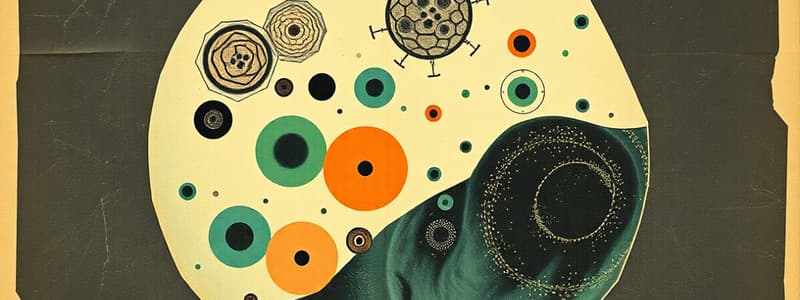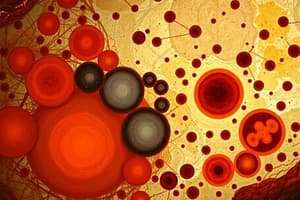Podcast
Questions and Answers
What is the primary function of the nucleus in a cell?
What is the primary function of the nucleus in a cell?
- Protein digestion
- Genetic control center (correct)
- Energy production
- Photosynthesis
Which organelle is responsible for the synthesis of ribosomal RNA?
Which organelle is responsible for the synthesis of ribosomal RNA?
- Peroxisome
- Centrosome
- Endoplasmic reticulum
- Nucleus (correct)
What function do peroxisomes serve in the cell?
What function do peroxisomes serve in the cell?
- DNA replication
- Synthesis of chlorophyll
- Production and conversion of hydrogen peroxide (correct)
- Transport of nutrients
What is the role of the centrosome in a cell?
What is the role of the centrosome in a cell?
Which structure provides structural support and motility within the cell?
Which structure provides structural support and motility within the cell?
How are microfilaments involved in cellular motility?
How are microfilaments involved in cellular motility?
What characterizes the nuclear envelope?
What characterizes the nuclear envelope?
Which of the following structures are centrioles composed of?
Which of the following structures are centrioles composed of?
What role do intermediate filaments play in muscle cells?
What role do intermediate filaments play in muscle cells?
What is the structural arrangement of microtubules in cilia and flagella called?
What is the structural arrangement of microtubules in cilia and flagella called?
Which of the following statements about the extracellular matrix (ECM) is true?
Which of the following statements about the extracellular matrix (ECM) is true?
What type of protein is associated with bending the microtubules in cilia and flagella?
What type of protein is associated with bending the microtubules in cilia and flagella?
How do integrins function in relation to the extracellular matrix?
How do integrins function in relation to the extracellular matrix?
What is the diameter of actin filaments in muscle cells?
What is the diameter of actin filaments in muscle cells?
What is one primary function of microtubules in muscle cells?
What is one primary function of microtubules in muscle cells?
Which of the following correctly describes the size comparison of actin, intermediate filaments, and microtubules?
Which of the following correctly describes the size comparison of actin, intermediate filaments, and microtubules?
What type of cell junction prevents leakage of extracellular fluid across epithelial cells?
What type of cell junction prevents leakage of extracellular fluid across epithelial cells?
What is the primary function of anchoring junctions in animal tissues?
What is the primary function of anchoring junctions in animal tissues?
Which of the following statements about gap junctions is accurate?
Which of the following statements about gap junctions is accurate?
In cell fractionation, what process follows homogenization?
In cell fractionation, what process follows homogenization?
What is the role of microfilaments in the cytoskeleton?
What is the role of microfilaments in the cytoskeleton?
Which type of junction is likely found in tissues that experience constant mechanical stress, such as the skin and heart?
Which type of junction is likely found in tissues that experience constant mechanical stress, such as the skin and heart?
How does centrifugation assist in the study of cell organelles?
How does centrifugation assist in the study of cell organelles?
Which cellular structure is rich in mitochondria after centrifugation at high speeds?
Which cellular structure is rich in mitochondria after centrifugation at high speeds?
What is cell fractionation primarily used for in scientific research?
What is cell fractionation primarily used for in scientific research?
What role does the extracellular matrix perform in relation to cells?
What role does the extracellular matrix perform in relation to cells?
Flashcards
Nucleus function
Nucleus function
The nucleus controls cell activities by directing protein synthesis via messenger RNA (mRNA). It contains most of the cell's DNA.
Nuclear Envelope
Nuclear Envelope
The double membrane surrounding the nucleus, containing pores for material flow.
Peroxisomes
Peroxisomes
Specialized compartments that produce hydrogen peroxide and convert it into water. They perform various metabolic reactions.
Cytoskeleton
Cytoskeleton
Signup and view all the flashcards
Microfilaments composition
Microfilaments composition
Signup and view all the flashcards
Centrosome function
Centrosome function
Signup and view all the flashcards
Centrioles
Centrioles
Signup and view all the flashcards
Cell Fractionation Technique
Cell Fractionation Technique
Signup and view all the flashcards
Muscle cell actin filaments
Muscle cell actin filaments
Signup and view all the flashcards
Intermediate filaments
Intermediate filaments
Signup and view all the flashcards
Microtubules
Microtubules
Signup and view all the flashcards
Cilia and Flagella Structure
Cilia and Flagella Structure
Signup and view all the flashcards
Cilia and Flagella Movement
Cilia and Flagella Movement
Signup and view all the flashcards
Extracellular Matrix (ECM)
Extracellular Matrix (ECM)
Signup and view all the flashcards
Integrins
Integrins
Signup and view all the flashcards
Myosin motors in Muscle Contraction
Myosin motors in Muscle Contraction
Signup and view all the flashcards
Glycoprotein function
Glycoprotein function
Signup and view all the flashcards
Collagen fiber function
Collagen fiber function
Signup and view all the flashcards
Integrin function
Integrin function
Signup and view all the flashcards
Tight junction function
Tight junction function
Signup and view all the flashcards
Anchoring junction function
Anchoring junction function
Signup and view all the flashcards
Gap junction function
Gap junction function
Signup and view all the flashcards
Cell fractionation
Cell fractionation
Signup and view all the flashcards
Centrifugation function in fractionation
Centrifugation function in fractionation
Signup and view all the flashcards
Homogenization function
Homogenization function
Signup and view all the flashcards
Differential centrifugation
Differential centrifugation
Signup and view all the flashcards
Study Notes
Cellular Organelles
- Cells contain various organelles, including the nucleus, peroxisomes, and the endomembrane system.
The Nucleus
- The nucleus is the control center of the cell.
- It contains most of the cell's DNA.
- DNA directs protein synthesis by producing mRNA.
- Chromosomes are structures composed of DNA and proteins. Each chromosome contains a single DNA molecule.
- The nuclear envelope is a double membrane with pores that allow materials to move in and out of the nucleus.
- The nuclear envelope is connected to the endoplasmic reticulum.
- The nucleolus is a prominent structure within the nucleus, responsible for rRNA synthesis.
Peroxisomes
- Peroxisomes are metabolic compartments.
- Bounded by a single membrane.
- Produce hydrogen peroxide.
- Convert hydrogen peroxide to water.
- Perform various reactions with many different functions.
Centrosomes and Centrioles
- Microtubules grow out from a centrosome near the nucleus.
- The centrosome is a microtubule-organizing center.
- Animal cells have a centrosome with a pair of centrioles.
- Each centriole has nine triplets of microtubules arranged in a ring.
The Cytoskeleton
-
The cytoskeleton is a network of protein fibers that organizes the cell's structure and activities.
-
It provides structural support and motility, with interactions between the cytoskeleton's proteins and motor proteins driving many cellular functions.
-
Composed of three main types of fibers: microfilaments, intermediate filaments, and microtubules.
-
Microfilaments (actin filaments): support cell shape and are involved in motility. Contain myosin in addition to actin, and in muscle cells, thousands of actin filaments are arranged parallel to each other.
-
Intermediate filaments: reinforce cell shape and anchor organelles.
-
Microtubules (tubulin): give the cell rigidity and act as tracks for organelle movement.
- Microtubules have a 9+2 pattern, and are anchored to centrioles/basal bodies.
-
Cilia and flagella are made from microtubules, and are surrounded by plasma membrane.
Cilia and Flagella
- Cilia and flagella move by bending microtubules.
- Some protists use them for locomotion.
- Multicellular organisms use them for different purposes (eg. cilia sweep mucus in lungs, flagella move sperm).
- Both are made of microtubules wrapped in plasma membrane with a 9+2 structure.
- Move through bending of motor proteins called dynein feet.
The Extracellular Matrix (ECM)
- Animal cells synthesize and secrete an extracellular matrix (ECM).
- The ECM helps hold cells together in tissues and protects and supports the plasma membrane.
- The ECM attaches to cells through glycoproteins
- Integrins span the plasma membrane and connect to the microfilaments of the cytoskeleton.
Cell Junctions
- Adjacent cells communicate, interact, and adhere via specialized junctions.
- Tight junctions prevent leakage of extracellular fluid across layers of epithelial cells.
- Anchoring junctions hold cells together and attach them to components of the extracellular matrix, and are found in tissues prone to mechanical stress.
- Gap junctions form channels connecting adjacent cells to mediate the rapid exchange of molecules in many bodily systems and are associated with normal physiological function.
Cell Fractionation
- Cell fractionation separates major organelles from one another.
- Centrifuges are used to fractionate cells into their component parts.
- Enables scientists to determine functions of organelles.
- Biochemistry and cytology help relate cell function with structure.
Studying That Suits You
Use AI to generate personalized quizzes and flashcards to suit your learning preferences.



